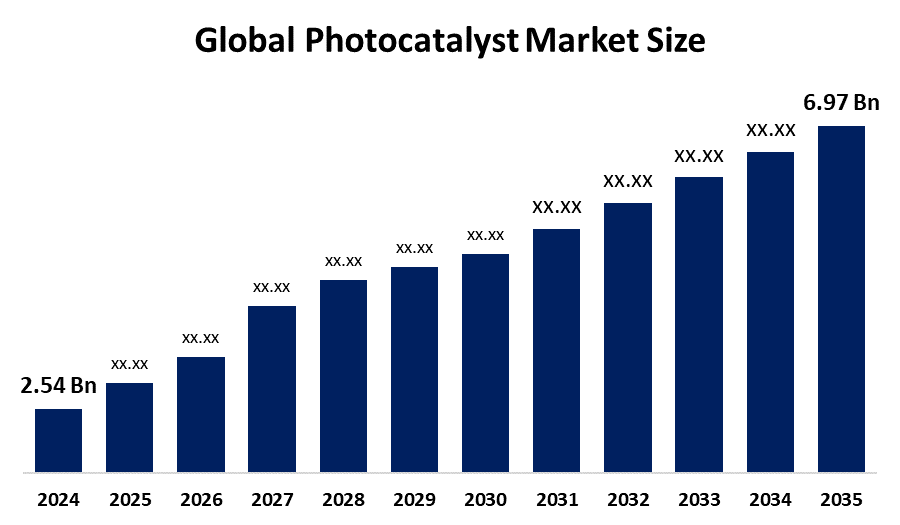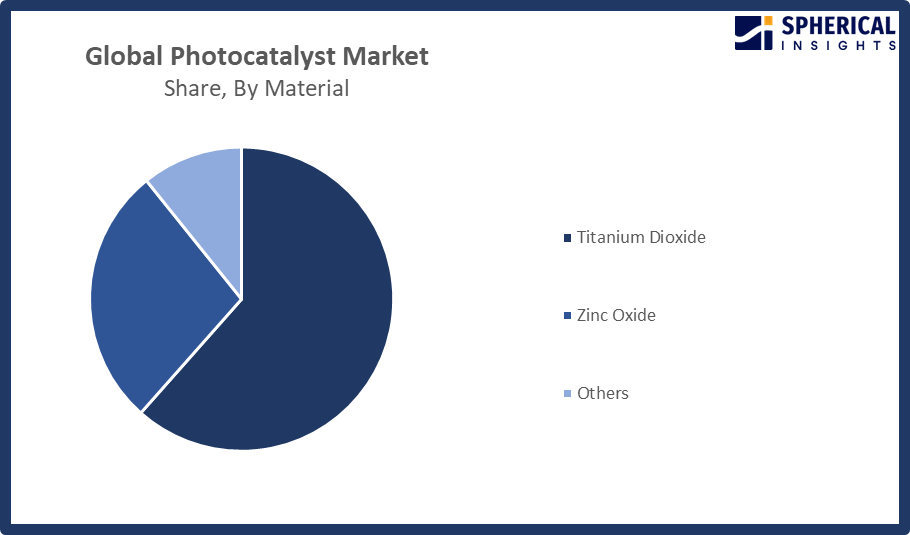Global Photocatalyst Market Size, Share, and COVID-19 Impact Analysis, By Material (Titanium Dioxide, Zinc Oxide, and Others), By Application (Self-cleaning, Air Purification, and Water Purification), and By Region (North America, Europe, Asia-Pacific, Latin America, Middle East, and Africa), Analysis and Forecast 2025 - 2035
Industry: Chemicals & MaterialsGlobal Photocatalyst Market Insights Forecasts to 2035
- The Global Photocatalyst Market Size Was Estimated at USD 2.54 Billion in 2024
- The Market Size is Expected to Grow at a CAGR of around 9.61% from 2025 to 2035
- The Worldwide Photocatalyst Market Size is Expected to Reach USD 6.97 Billion by 2035
- North America is expected to grow the fastest during the forecast period.

Get more details on this report -
According to a Research Report Published by Spherical Insights and Consulting, The Global Photocatalyst Market Size was worth around USD 2.54 Billion in 2024 and is predicted to Grow to around USD 6.97 Billion by 2035 with a compound annual growth rate (CAGR) of 9.61% from 2025 to 2035. Water treatment is expected to rise globally as a result of growing water shortages brought on by fast industrial growth and the depletion of freshwater supplies. Due to their exceptional chemical qualities, photocatalysts improve the water treatment process, which is anticipated to spur expansion throughout the forecast period.
Market Overview
The global photocatalyst market involves the materials that accelerate chemical reactions under light exposure, primarily used for air purification, water treatment, and self-cleaning surfaces, driving sustainable environmental and industrial applications. The growing need for low VOC coatings in the building and construction sector, which can break down organic compounds, is driving the worldwide photocatalyst markets rapid expansion. The market is expanding due to Europes rising economy and significant construction spending. By virtue of the Photocatalysis business Association of Japan (PIAJ), Japan is the country with the most patents in the business. Since photocatalysts are safe for the environment and non toxic, they are subject to few regulations, which encourages their use. Although external substitutes are nonexistent, internal alternatives such as ZnO and CdS provide TiO2 with affordable alternatives. Global use of photocatalysts is anticipated to accelerate due to ongoing research and development activities, especially from organisations such as Tokyo University of Science, and the early stages of product commercialization.
The market for photocatalysts is growing due to advancements in nano textured TiO2 coatings that enhance air quality and reduce building maintenance expenses by 40%. Using solar powered photocatalytic systems, municipalities may degrade pesticides by up to 99.8%. The need for TiO2 based air purifiers in buildings and automobiles is driven by stricter VOC regulations. In the meantime, transparent, self cleaning coatings for consumer electronics are made possible by visible light plasmonic nanocomposites such as Ag/AgCl glass, which promote energy efficiency, sustainability, and hygienic practices in electrical, environmental, and construction applications.
Report Coverage
This research report categorizes the photocatalyst market based on various segments and regions, forecasts revenue growth, and analyzes trends in each submarket. The report analyses the key growth drivers, opportunities, and challenges influencing the photocatalyst market. Recent market developments and competitive strategies such as expansion, type launch, development, partnership, merger, and acquisition, have been included to draw the competitive landscape in the market. The report strategically identifies and profiles the key market players and analyses their core competencies in each sub-segment of the photocatalyst market.
Global Photocatalyst Market Report Coverage
| Report Coverage | Details |
|---|---|
| Base Year: | 2024 |
| Market Size in 2024: | USD 2.54 Billion |
| Forecast Period: | 2025-2035 |
| Forecast Period CAGR 2025-2035 : | 9.61% |
| 2035 Value Projection: | USD 6.97 Billion |
| Historical Data for: | 2020-2023 |
| No. of Pages: | 166 |
| Tables, Charts & Figures: | 153 |
| Segments covered: | By Material, By Application and COVID-19 Impact Analysis |
| Companies covered:: | KRONOS Worldwide Inc. Tronox Holdings Plc. The Chemours Company, LB Group, ISHIHARA SANGYO KAISHA, LTD., The Chemours Company, Lomon Billions Group Co., Ltd., TAYCA Corporation, BASF SE, Showa Denko K.K.. TOTO LTD., Nanoptek Corporation, and Others |
| Pitfalls & Challenges: | COVID-19 Impact, Challenges, Future, Growth, & Analysis |
Get more details on this report -
Driving Factors
The growing use of nano-textured TiO2 coatings in building for affordable, self-cleaning, and air-purifying façades is one of the main drivers propelling the photocatalyst market. Increasing use in municipal water treatment reduces reliance on electricity by employing solar-powered systems to degrade pollutants up to 99.8%. Demand for photocatalytic air purifiers in cars and buildings is increased by stricter VOC laws. Furthermore, advancements in Ag/AgCl-glass coatings and visible-light plasmonic nanocomposites improve consumer electronics' transparency and antibacterial capabilities, which together propel market expansion in electrical, construction, and environmental applications.
Restraining Factors
High capital expenditures for industrial-scale reactors, which are fuelled by expensive UV-lamp arrays, flow systems, and fouling mitigation that frequently surpass initial budgets, are a major barrier to the photocatalyst business. Furthermore, catalyst deactivation due to electron-hole recombination and surface fouling lowers efficiency and necessitates energy-intensive regeneration. Modular and hybrid reactor designs provide some respite, but their widespread use and profitability in industrial applications are still constrained by their high maintenance costs and material complexity.
Market Segmentation
The Photocatalyst market share is classified into material and application.
- The titanium dioxide segment dominated the market in 2024, approximately 62.2% and is projected to grow at a substantial CAGR during the forecast period.
Based on the material, the photocatalyst market is divided into titanium dioxide, zinc oxide, and others. Among these, the titanium dioxide segment dominated the market in 2024 and is projected to grow at a substantial CAGR during the forecast period. TiO2's remarkable chemical and physical stability is anticipated to propel expansion. Furthermore, because there aren't many substitutes for TiO2, the market for the substance is predicted to grow. market share of photocatalysts due to their established production scale and decades of formulation expertise. Even when antidumping duties alter supply logistics, concurrent advancements like Ti self-doping via triethanolamine pathways expand its visible-light window, strengthening performance leadership.

Get more details on this report -
- The self-cleaning segment accounted for the largest share in 2024, approximately 60.5% and is anticipated to grow at a significant CAGR during the forecast period.
Based on the application, the photocatalyst market is divided into self-cleaning, air purification, and water purification. Among these, the self-cleaning segment accounted for the largest share in 2024 and is anticipated to grow at a significant CAGR during the forecast period. This application is currently widely used in the building and construction sector, and its use is anticipated to increase in tandem with the industry's growing demand. Consequently, the market for photocatalysts is anticipated to expand throughout the forecast period. taking advantage of its widespread use in phone glass, car clearcoats and building facades. Savings on life-cycle maintenance and improved urban aesthetics are two factors that make architectural cladding particularly popular. As workplaces modify HVAC systems to meet more stringent VOC limits, air purification comes in second, and water treatment becomes a tertiary defence against trace organics that avoid biological processes.
Regional Segment Analysis of the Photocatalyst Market
- North America (U.S., Canada, Mexico)
- Europe (Germany, France, U.K., Italy, Spain, Rest of Europe)
- Asia-Pacific (China, Japan, India, Rest of APAC)
- South America (Brazil and the Rest of South America)
- The Middle East and Africa (UAE, South Africa, Rest of MEA)
Asia Pacific is anticipated to hold the largest share with approximately 66% of the Photocatalyst market over the predicted timeframe.

Get more details on this report -
Asia Pacific is anticipated to hold the largest share of the photocatalyst market over the predicted timeframe. Asia Pacific is expected to have the greatest share of the photocatalyst market due to factors including growing environmental consciousness, expanding construction activities, and rapid urbanisation. Demand in the region is further increased by robust government programs supporting green technologies in nations like South Korea, China, and Japan. Key elements sustaining market dominance include Japan's considerable R&D expenditures, leadership in photocatalyst patents, and expanding use in air purification and water treatment systems.
North America is expected to grow the fastest market share with approximately 32% at a rapid CAGR in the photocatalyst market during the forecast period. EPA VOC limitations accelerate vehicle fuel-vapor controls and HVAC retrofits. ZnO-based water-splitting demonstrations are encouraged by federal clean-hydrogen credits, while municipal utilities use passive solar tertiary treatment to comply with trace-contaminant discharge permits. Mexico's growing industrial base and Canadian green construction regulations increase regional volume outside of the US.
Europe is expected to grow at a rapid CAGR in the photocatalyst market during the forecast period. The circular economy provisions of the Green Deal help Europe by directing subsidies towards agrivoltaic pilot projects that combine transparent PV with photocatalytic glass, as well as sustainable building. Local pigment manufacturers are encouraged to expand into higher-margin catalyst grades by antidumping taxes on Chinese TiO2, which shortens supply chains. Particularly in isolated farming and mining camps, South America, the Middle East, and Africa are early-stage regions where point-of-use water treatment and solar-panel coatings can outperform traditional methods.
Competitive Analysis:
The report offers the appropriate analysis of the key organizations/companies involved within the photocatalyst market, along with a comparative evaluation primarily based on their type of offering, business overviews, geographic presence, enterprise strategies, segment market share, and SWOT analysis. The report also provides an elaborative analysis focusing on the current news and developments of the companies, which includes type development, innovations, joint ventures, partnerships, mergers & acquisitions, strategic alliances, and others. This allows for the evaluation of the overall competition within the market.
List of Key Companies
- KRONOS Worldwide Inc
- Tronox Holdings Plc
- The Chemours Company
- LB Group
- ISHIHARA SANGYO KAISHA, LTD.
- The Chemours Company
- Lomon Billions Group Co., Ltd.
- TAYCA Corporation
- BASF SE
- Showa Denko K.K.
- TOTO LTD.
- Nanoptek Corporation
- Others
Key Target Audience
- Market Players
- Investors
- End-users
- Government Authorities
- Consulting and Research Firm
- Venture capitalists
- Value-Added Resellers (VARs)
Recent Development
- In June 2025, Researchers at the Chinese Academy of Sciences unveiled TiO2 catalysts doped with subnanometric MoOx clusters achieving 95% selectivity in methane oxidation, curbing CO2 by products for natural gas processing.
- In December 2024, BASF inaugurated a catalyst research centre dedicated to sustainable chemistries, with photocatalytic water-remediation and solar fuel prototypes among its first pilot lines.
Market Segment
This study forecasts revenue at global, regional, and country levels from 2020 to 2035. Spherical Insights has segmented the photocatalyst market based on the below-mentioned segments:
Global Photocatalyst Market, By Material
- Titanium Dioxide
- Zinc Oxide
- Others
Global Photocatalyst Market, By Application
- Self-cleaning
- Air Purification
- Water Purification
Global Photocatalyst Market, By Regional Analysis
- North America
- US
- Canada
- Mexico
- Europe
- Germany
- UK
- France
- Italy
- Spain
- Russia
- Rest of Europe
- Asia Pacific
- China
- Japan
- India
- South Korea
- Australia
- Rest of Asia Pacific
- South America
- Brazil
- Argentina
- Rest of South America
- Middle East & Africa
- UAE
- Saudi Arabia
- Qatar
- South Africa
- Rest of the Middle East & Africa
Frequently Asked Questions (FAQ)
-
1. What is the CAGR of the Photocatalyst market over the forecast period?The global Photocatalyst market is projected to expand at a CAGR of 9.61% during the forecast period.
-
2. What is the market size of the Photocatalyst market?The global Photocatalyst market size is expected to grow from USD 2.54 Billion in 2024 to USD 6.97 Billion by 2035, at a CAGR of 9.61% during the forecast period 2025-2035.
-
3. Which region holds the largest share of the Photocatalyst market?Asia Pacific is anticipated to hold the largest share of the Photocatalyst market over the predicted timeframe.
-
4. Who are the top 10 companies operating in the global Photocatalyst market?KRONOS Worldwide Inc, Tronox Holdings Plc, The Chemours Company, LB Group, ISHIHARA SANGYO KAISHA, LTD., The Chemours Company, Lomon Billions Group Co., Ltd., TAYCA Corporation, BASF SE, and Shōwa Denko K.K.
-
5. What factors are driving the growth of the Photocatalyst market?Growing demand for environmentally friendly materials, increased use in self-cleaning coatings, building applications, and air and water purification are driving the expansion of the photocatalyst market. The market expansion in the commercial, residential, and industrial sectors is further enhanced by technological developments, stringent environmental laws, and increasing R&D investments supporting visible-light-responsive photocatalysts.
-
6. What are the market trends in the Photocatalyst market?Key trends in the photocatalyst market include advancements in visible-light-responsive materials, increasing use of TiO₂-based coatings in construction, and rising adoption in water and air purification systems. Integration into consumer electronics and development of plasmonic nanocomposites for enhanced efficiency under indoor lighting are also shaping market growth.
-
7. What are the main challenges restricting wider adoption of the Photocatalyst market?Wider adoption of photocatalysts is restricted by high capital costs for industrial reactors, catalyst deactivation from fouling and electron-hole recombination, energy-intensive regeneration, and complex material requirements, limiting large-scale industrial and commercial implementation.
Need help to buy this report?